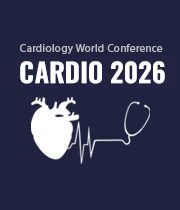Pace Mapping
Pace mapping stands as a pivotal method within the realm of electrophysiology, utilized to investigate and pinpoint the origins of abnormal heart rhythms, commonly known as arrhythmias. In this diagnostic procedure, a comprehensive map of the heart's electrical activity is meticulously crafted by pacing the heart at various points. This involves the systematic stimulation of diverse regions of the heart to analyze responses, enabling healthcare professionals to identify potential sites responsible for arrhythmias. With its ability to guide ablation procedures, pace mapping aids electrophysiologists in precisely targeting and eliminating abnormal tissue, which is the root cause of irregular heartbeats. The precision offered by this technique significantly enhances the success rates of ablation procedures, ultimately contributing to a more effective and tailored approach to managing cardiac arrhythmias.

Arthur J Siegel
Massachusetts General Hospital, United States
Sergey Suchkov
N. D. Zelinskii Institute for Organic Chemistry of the Russian Academy of Sciences, Russian Federation
Narendra Kumar
HeartbeatsZ Academy, United Kingdom
Arthur J Siegel
Massachusetts General Hospital, United States
Yong Xiao Wang
Albany Medical Center, United States
Narendra Kumar
HeartbeatsZ Academy, United Kingdom



Title : New recommendations for the prevention of sudden cardiac death in athletes and recreational sports
Sekib Sokolovic, ASA Hospital Sarajevo, Bosnia and Herzegowina
Title : Coronary revascularization in patients with diabetes: Prospects for stenting in patients with type 1 diabetes and coronary artery disease
Mekhman N Mamedov, National Research Center for Therapy and Preventive Medicine, Russian Federation
Title : An adult case of polysplenia syndrome associated with sinus node dysfunction
Apoorva Tripathi, Oxford University Hospitals, United Kingdom
Title : Personalized and precision medicine (PPM) as a unique healthcare model through biodesign-driven translational applications and cardiology-related healthcare marketing to secure the human healthcare and biosafety
Sergey Suchkov, N. D. Zelinskii Institute for Organic Chemistry of the Russian Academy of Sciences, Russian Federation
Title : A unique cell-driven phenomenon in the heart and the promising future of the innovative translational tools to manage cardiac self-renewal and regeneration
Sergey Suchkov, N. D. Zelinskii Institute for Organic Chemistry of the Russian Academy of Sciences, Russian Federation
Title : Young hearts at risk: Hidden cardiovascular damage and the role of social determinants of health among youth with type 1 diabetes in Kenya
Phoebe Wamalwa, Ministry of Health, Kenya